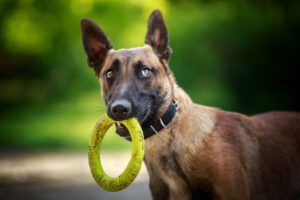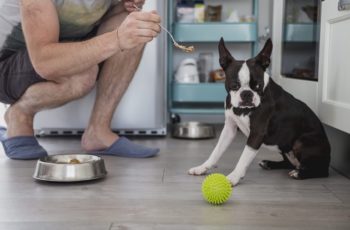
Resist your first impulse to snap back at your dog.
Instead, do this:
- Stop. Whatever you did that caused your dog to growl, stop doing it. Immediately. If you were walking toward him, stand still. If you were reaching toward him, stop reaching. If you were trying to take the toy or bone away from him, stop trying.
- Analyze. Your next action depends on your lightning-fast analysis of the situation. If your dog is about to bite you, retreat. Quickly. If you’re confident he won’t escalate, stay still. If you aren’t sure, retreat. Err on the side of caution. Complete your analysis by identifying what resource he had that was valuable enough to guard, and what you were doing that caused him to guard.
- Retreat. If you already retreated because you feared a bite, go on to #4. If you stayed still, wait for some lessening of his tension and then retreat. Here’s the dilemma: dogs give off guarding signals – a freeze, a hard stare, stiffening of the body, a growl, snarl, snap, or bite – to make you go away and leave them alone with their valuable objects. Your safety is the number one priority, so if a bite is imminent, it’s appropriate to skedaddle. However, by doing so you reinforce the guarding behavior. “Yes!” says Dog. “That freeze worked; it made my human go away.” Reinforced behaviors are likely to repeat or increase, so you can expect more guarding next time. If, instead, you are safe to stay still and wait for some relaxation of tension and then leave, you reinforce calmer behavior. “Hmmmmm,” says Dog. “Relaxing made my human go away.” If you can do this safely, you increase his relaxation when you are near him and decrease his guarding behavior.
- Manage. Give your dog guardable things only when you won’t have to take them away. Crates are good places for a resource guarder to enjoy his valuable objects. When he’s crated with good stuff, don’t mess with him, and don’t let anyone else mess with him. When small children are around, put him away – for his sake and theirs – since you may not always know what he’ll decide to guard, especially when kids bring their own toys to play with.
- Train. Work with a good, positive behavior professional to modify your dog’s guarding behavior so he no longer feels stressed when humans are around his good stuff. Teach him to “trade” on verbal cue for a high value treat such as chicken, starting with low value objects and working up to high value, so he’ll happily give you his things on cue when you need him to. Out-think your dog. Resource guarding behavior is not a good place for a battle of wills.
To learn more about this aggressive behavior and others as well as ways to modify it, purchase and download the ebook Canine Aggression, from Whole Dog Journal.
Please follow and like us:


